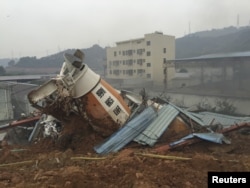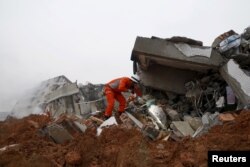Rescue workers in southern China are still digging through rubble from an enormous urban mudslide, searching for 91 people missing in Sunday’s disaster at an industrial park in Shenzhen, Guangdong province.
Authorities said a huge pile of construction debris had collapsed at a former stone quarry, sending tons of material hurtling toward more than 30 buildings in the park below. There have been no confirmed deaths, while more than 14 people have been reported injured.
The mudslide occurred at around 11:40 a.m. Sunday and covered more than 60,000 square meters at the Hengtaiyu Industrial Park in the city’s Guangming New District. Making matters worse, a nearby section of the arterial West-East Gas Pipeline exploded, state-run China Central Television reported.
Liu Guonan, a researcher from China Academy of Railway Science, told a media briefing Monday afternoon there is no precedent in China for Sunday’s devastation.
“This has been the worst landslide I’ve ever seen in the past three decades after I entered the profession. The disaster, triggered by such a large scale of landslide, has been rare in the country’s history.”
Mud up to eight meters deep
According to state media, 14 factories, two office buildings, 13 low-rise buildings and three dormitories were among the buildings flattened. And by Sunday evening more than 900 people had been evacuated from the site, official Xinhua reported.
Although the site was too muddy for rescue workers to enter on the first day, teams of rescue workers have managed to detect signs of life in several spots, Yang Shengjun, director of the city’s housing and construction bureau, told a media briefing Monday afternoon.
“As of 12 p.m. [Monday], we’ve set up 172 heavy machines on site with sufficient rescue resources in place. And in some spots, we’re now rushing to rescue those buried alive after signs of life have been detected,” Yang said.
President Xi Jinping has instructed the local government to do whatever it can to minimize casualties, the official added.
A witness, who fled the site unharmed on Sunday, told local media that the damage to his company’s building would have been worse “if it weren’t for a big fish pond nearby, which worked as a buffer to absorb mounds of mud.”
An 8-year-old survivor told the CCTV that she and her father had to jump off their building to survive the mudslide.
“When the mountain collapsed, me and my father…. After my father threw me down, he had to jump off the building himself and hurt his back badly at that time,” Xiao Qi said from her hospital bed.
The Ministry of Land Resources blamed the landslide on a mountain of waste construction mud in the vicinity. The ministry said, in a written statement on its website, that the landslide happened after a dump of earth and construction rubbish, as high as a 20-story building, collapsed. “The dump was too large and the slopes to steep, making it unstable,” the ministry statement said.
Questions over industrial safety
The cause of the landslide has raised questions about safety standards in the city’s industrial parks, following three decades of breakneck economic growth.
Chinese-language Beijing Youth Daily argued that “the mudslide is nothing of a natural disaster, but a devastating man-made disaster.”
Local media reported that the managing company behind the dump site appears to have a close relationship with the city government after having had won at least six projects, organized by the government, in the past two-and-a-half years.
A geology professor in Guangdong, who requested anonymity when speaking with VOA, said local officials, if found negligent, should be held responsible for the lack of a firm mudslide dam at the foothill, which keeps construction wastes from sliding out of an abandoned quarry.
“Personally, I think that there were probably too much dump of debris, used to refill [the abandoned quarry]. But after the refill on the top, there should have had built a solid dam at the bottom to keep the slope from sliding,” the professor said, adding that an overhaul should be considered in some parts of southern China, where torrential rains are likely to turn soil structure unstable.
Authorities appeared to do little to censor discussion of the disaster online.
A Weibo user asked why the government couldn’t have found any measures to prevent the occurrence of mudslide. “The blasts in Tianjin were settled with taxpayers’ money to cover the faults of officials, who should be held responsible. What now with this disaster?” the user wrote.
Another user said that this is “a blood-shed lesson. We don’t need a city’s landscape to look dazzling. What we need is a safe living environment.”










